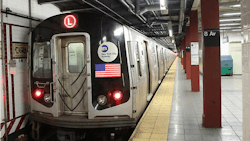Humatics awarded MTA contract to develop interoperable Ultra Wideband train positioning
The Metropolitan Transportation Authority (MTA) has awarded a contract to Humantics and its partner, Siemens, to develop an interoperable Ultra-Wideband (UWB) solution over the course of 14.5 months.
This work expands on the success of the 2019 pilot project which determined the effectiveness of using UWB in conjunction with communications-based train control (CBTC) systems. This scope of work will deliver an interoperable UWB specification enabling competition, expanding the UWB ecosystem and building the foundation for UWB to be used in revenue service in New York City.
“Humatics is pleased to work with the MTA, our pilot partner Siemens and the broader mobility community to continue to advance next generation transit technologies. Our 2019 pilot, along with other projects, has demonstrated the capabilities of UWB in train control and we’re excited to deliver interoperable UWB technology that will enable competition and promote innovation beneficial to the MTA and the New York City ridership,” said Shawn Henry, CEO, Humatics. “This project demonstrates the commitment of the MTA to UWB technologies and establishes an interoperable solution that is critical for accelerating signal modernization.”
Humantics notes upgrading the MTA’s subway system with UWB and CBTC technology will improve overall system reliability, availability and increase capacity which will significantly improve the passenger experience.
Humatics expects to build upon the 2019 UWB pilot success where 5.5 miles of track and four trains were outfitted with UWB technology that successfully passed train control functional testing and were deemed safety certifiable by independent assessors. The pilot was also robust, having accumulated more than one million hours of operation. Additionally, the pilot showed UWB equipment can replace several pieces of traditional CBTC positioning equipment, and is easier to install and maintain, reducing operating expenses.
In New York City, UWB is the primary positioning sensor used by the Humatics Rail Navigation System (HRNS), a drop-in replacement for traditional railway odometry sensors such as tachometers, transponders and doppler radars. The HRNS is a navigation system based on sensor fusion algorithms that leverage the right sensors to solve challenging navigation problems.
UWB, along with sensors such as Inertial Measurement Units (IMU) and Global Navigation Satellite System (GNSS), are fused together to provide incredibly precise position, speed and acceleration data to train control systems such as CBTC, Positive Train Control (PTC) and the European Rail Traffic Management System (ERTMS).
